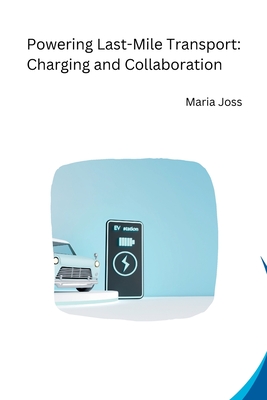You are here
Back to topPowering Last-Mile Transport: Charging and Collaboration (Paperback)
Email or call for price.
Description
Tackling Climate Change: Speeding up Transport Sector Emission Cuts through Electrification
In the fight against climate change, there has been a growing global awareness of the urgent need to address its detrimental effects resulting from rising temperatures. Reducing greenhouse gas (GHG) emissions has become a paramount objective worldwide to mitigate climate change. Recognizing the urgency of the situation, the United Nations (UN) introduced the Paris Agreement-an international endeavor aimed at limiting global warming to less than 2 C above pre-industrial levels 1]. Consequently, nations are legally committed to decreasing their GHG emissions 1], necessitating the exploration of additional strategies for emission reduction.
Since 2010, annual global GHG emissions have consistently remained at around 50 to 60 Gt CO₂-equivalents 2]. In 2021, direct CO₂ emissions accounted for approximately 33 Gt CO₂-equivalents 3]. Within these emissions, the transport sector has played a significant role, contributing approximately 23% of the world's direct CO₂ emissions in 2021 4]. Therefore, it is crucial to find effective solutions to reduce GHG emissions in the transport sector in order to achieve global emission reduction goals. One such solution that is gaining momentum is the transition from internal combustion engine vehicles (ICEVs) to battery electric vehicles (BEVs) in the road transport sector.
In Sweden, the road transport sector was responsible for 13.62 Mt of GHG emissions in 2020, accounting for around 29.4% of the national total 5, 6]. Addressing emissions from this sector is a crucial step in mitigating climate change within the country. The Swedish government has emphasized the importance of transportation electrification by establishing a commission for the electrification of all transport in 2020. The aim of this commission is to promote widespread adoption of BEVs while phasing out ICEVs within a two-year timeframe 7]. As a result, additional governmental initiatives have been implemented to assess the drivers and impacts of this electrification process.
Within the road transport sector, various vehicle types are used for different purposes, each with varying levels of GHG emissions. While significant attention has been given to electrifying private passenger vehicles and heavy-duty trucks, Light-Duty Trucks (LDTs) have received relatively less focus. Surprisingly, LDTs accounted for 1.22 Mt of GHG emissions in 2020, making them the third-largest GHG emitter in the road transport sector 5]. At the same time, the use of LDTs has been increasing in recent years 5], primarily driven by the growth of e-commerce, where LDTs are extensively employed as delivery vehicles for last-mile transportation

